If you look at any picture of containers on a shipping vessel, what do you see?
For the most part, you probably only notice a bunch of rectangular boxes. Sure, they boast a bunch of different colors (like yellow, blue, red, white, or green), but for the most part, none of them stand out from each other. The truth is, though, there are a variety of ocean shipping containers used to transport goods from one country to another. While most containers might look the same, their uses can vary greatly.
Learning about your ocean shipping container options will help you choose the most appropriate one for transporting your goods. This will help you streamline your shipping strategy and avoid a costly mistake if you use containers unsuited for your products. Ultimately, understanding ocean shipping containers means your product is more likely to arrive safe and intact at destination.
Before you check out specific types of containers, there’s some basic information about all of them you need to know.
General Ocean Shipping Container Information
A few things to keep in mind as you start looking at containers you can use for your shipment:
- Container sizes are listed in feet.
- Containers’ internal and door dimensions are generally standard, but could change depending on your carrier. Because of these slight differences, you always want to double-check with your carrier or forwarder on specific measurements during negotiations.
- Maximum payloads per container (not listed here) could vary depending on your carrier, so make sure you also verify this information before you ship. You’ll also need to make sure the weight of your containers is acceptable for ground and rail transportation.
- Most containers are made of steel, with corrugated sides, and unless stated otherwise, container bottoms are usually made of treated wood planks or plywood.
- Remember in situations where your goods are concentrated or heavier than normal, you must ensure they won’t break the bottom of the container.
Types of Ocean Shipping Containers
Depending on your cargo, the type of container you will need can vary slightly from shipment to shipment. What works for you today, might not in the future. Check out these eight different types of ocean shipping containers as you plan for any upcoming shipments:
Standard Container
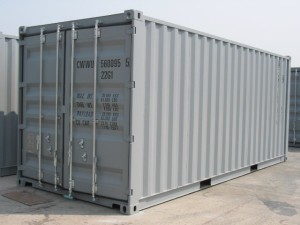
Description: Standard containers are completely-enclosed units with rigid walls, roof, and floor. At least one end wall has a door for ease of access.
Available sizes (length x width x height):
– 20’ x 8’ x 8’6”
– 40’ x 8’ x 8’6”
– 40’ x 8’ x 9’6” (high cube)
Use: Standard containers are the most popular shipping option, and are used for the majority of the world’s dry cargoes packaged in boxes, bags, bales, pallets, etc. Both the 20’ and 40’ containers tend to carry the same amount of weight, so it’s best to ship heavier cargo in a maxed-out 20’ container. The 40’ high cube, of course, is best used for taller products. Additionally, some of these containers are specifically fitted for transporting hanging garments.
Hardtop Container
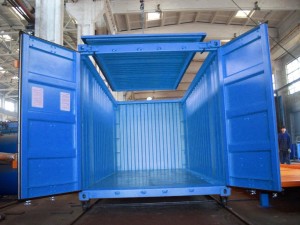
Description: Made specifically with heavier cargo in mind, hardtop containers are created with steel roofs which can be removed for ease of packing. The removable roofs make it easier for cranes to help load goods in the container. The door header on the end wall(s) can be swung out.
Available sizes (length x width x height):
– 20’ x 8’ x 8’6”
– 40’ x 8’ x 8’6”
– 40’ x 8’ x 9’6” (high cube)
Use: Hardtop containers are best suited for heavy loads. They’re even capable of carrying taller items, especially the 40’ and 40’ high cube options. In the case of very tall cargo, the roof of a hardtop container can be left completely open and lashed to the inside wall of the container (which requires no more than about 5 ⅛” of space).
Flat Rack Container
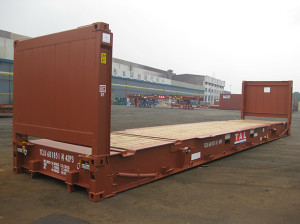
Description: Flat racks are containers with a steel frame, no sidewalls, a wood floor, and fixed or collapsible end walls. Some flat racks even have end walls which fold flush with the base.
Available sizes (length x width x height):
– 20’ x 8’ x 8’6”
– 40’ x 8’ x 8’6”
– 40’ x 8’ x 9’6” (high cube)
Use: Flat racks have very strong floors, so they’re generally used to transport heavy, bulky, or over-sized (i.e. over-width or over-length) cargo. Flat racks can be stacked on top of each other if properly packed, allowing for the transport of lots of large products.
Platform Container
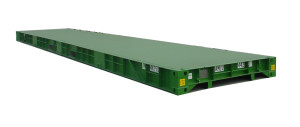
Description: A platform container is simply a floor structure without any side or end walls. They’re made of a steel frame and a wooden floor.
Available sizes (length x width x height):
– 20’ x 8’ x 8’6”
– 40’ x 8’ x 8’6”
Use: Platform containers are built to carry extremely heavy and oversized loads, even ones concentrated on different parts of the container floor.
Open Top Container
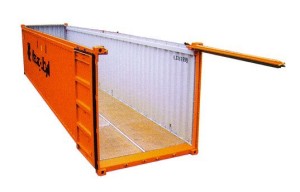
Description: Open top containers are essentially general/standard containers without a rigid roof. Instead, they boast a flexible tarpaulin roof, which can be moved or entirely removed. The tarpaulin is also supported on either movable or removable bows. The door header on the end wall(s) can be swung out.
Available sizes (length x width x height):
– 20’ x 8’ x 8’6”
– 40’ x 8’ x 8’6”
– 40’ x 8’ x 9’6” (high cube)
Use: Open top containers work well for transporting overheight cargo, since the tarpaulin can be moved to allow crane access to the top of the container. However, roof bows can help stabilize the container, so some overheight items may be better suited for flat racks. Open tops are also good options for heavy or bulky cargo.
Reefer Container
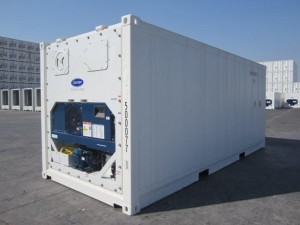
Description: Short for “refrigerated container,” reefers are thermal, insulated units with compressors to either heat or cool the container’s packaged cargo. The walls of reefers usually contain polyurethane foam for efficient insulation (known as “sandwich construction”). Many reefer containers also boast adjustable ventilation, allowing for better internal airflow.
Available sizes (length x width x height):
– 20’ x 8’ x 8’6”
– 40’ x 8’ x 8’6”
– 40’ x 8’ x 9’6” (high cube)
Use: Reefers are specifically created to transport temperature-sensitive goods, like produce and other types of perishable goods. Cargo which needs to stay at a constant temperature above or below freezing should be transported in reefer containers.
Insulated Container
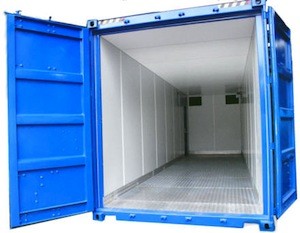
Description: An insulated container is similar to the reefer container. It has Polyurethane foam on its walls to maximize insulation, but uses the vessels cooling or “clip-on”unit for temperature control.
Available sizes (length x width x height):
– 20’ x 8’ x 8’6”
– 40’ x 8’ x 8’6”
Uses: This container is recommended for cargo that needs to stay at constant temperatures at or below freezing.
These seven types of ocean shipping containers are all you should need to get started transporting goods. Carriers around the world will have all these container options available to you, albeit with slight differences in dimensions and weight capacity. Check with your carrier to determine which container is best suited for your cargo needs, and you’ll be all set for shipping overseas!
Have a question about which container may be right for you? Leave us a comment below with the type of cargo you want to ship and we can give you some general guidance!

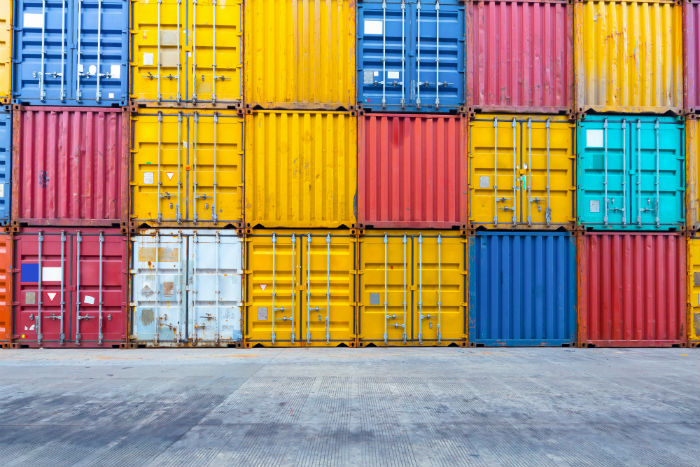

42 Comments on “Complete Guide to Ocean Shipping Containers”
It’s great that there are insulated containers. I can see how there are several products that need to be shipped that would need to be in an insulated space. It’s interesting that this type of container uses polyurethane foam on the walls to maximize the effectiveness of the insulation. I should keep that in mind in case I ever need this.
Hi Judy, glad you found the article interesting! Yes, the insulated containers are a great option for many different product types.
Thank you Eli, very informative, I wonder if you happen to know of a report that list the top 5 companies that owns shipping containers and in the business of leasing them. Thanks in advance.
Hi Ra’ed – glad you enjoyed the article! Unfortunately, we do not have a report with that information. Thank you!
Hi Eli,
Love to see your post. Thank you for sharing this. Shipping containers can be quite helpful if you wish to keep your valuable products in a safe place. These storage containers can be purchased in all sizes and shapes so as to choose the one which suits your preferences.
Ocean containers are built to agreed standard dimensions so cargo can be loaded and unloaded, stacked and transported efficiently by container ship, rail and semi-trailer trucks without being opened.
Thanks for being such an informative post.
Regards
Joshua Knetes
Hi Joshua – we are glad you found this article helpful!
Hi, I’m trying to determine what temperatures the inside of a steel container will reach based on external temperatures to determine whether my cargo, nutritional supplements, will require climate controlled containers. Is there somewhere I can find such data?
Hi Jeffrey – The temperature inside a shipping container usually doubles the temperature on the outside. E.G. If the exterior temperature is 25°C the interior will be around 48/50°C.
Also, the color of the container plays a role in the temperature. A darker color like brown or orange will absorb more heat, making the interior warmer by a few degrees than a light toned one. We hope this helps.
hi! do you guys ship on the americas? or jus sell the containers, I am lookin to send some stuff and i found a good company called kingocean but you need to have the container ready, the dont give it to you.
Hi Johanna – our team is more than happy to help. Please send an email with your cargo details to solutions@shiplilly.com and a member of our team will be in contact.
The type of shipping containers that need to be used strictly depends upon the type of material that needs to be shipped. The size, material and the quantity all of these factors depend upon the containers that should be used.
Can any type of container be used within the palletized container– in other words, do all of our boxes need to be corrugated cardboard or can we also pack items in plastic totes that then go on the pallet?
Hello Debra – It is perfectly fine to use plastic totes. Thank you for reading us!
muy buen post
muy buen post sii
Superb article, it contains a vast knowledge of ocean container. Thankyou
Hello Mark – We are glad you enjoyed it. Thank you for reading us!
Hi!
I’m interested to send a standard container to Duala, Camerun, Africa. Can you give me an estimate? I’m planning to buy the container and to leave it there.’
Thank you,
Hello Gabriela – thank you for reaching out. We can definitely help, I have forwarded your information to our support team. They should be contacting you very soon. Feel free to also email our sales team directly at solutions@shiplilly.com or call us at 888-464-5459
Nice information. In my opinion, the type of shipping containers that need to be used strictly depends upon the type of material that needs to be shipped. The size, material, and quality of those factors depend upon the containers.
Nice Blog!! The content you have shared is very elaborative and informative. Thanks a lot for sharing such a great piece of knowledge with us.
Excellent post I usually use the services of a company called King Ocean (www.kingocean.com), excellent work they do, but I need to send goods to Europe, do you have that service?
Hi Willerd – Yes, we provide services to almost every country in Europe, please contact us directly by email at solutions@shiplilly.com or call us at 888-464-5459. Thank you
Such a nice information. These containers are highly popular among the real estate and construction industry.
Thanks for such valuable information
Hello James – We are glad you enjoyed it. Thank you for reading us!
It’s interesting to know that ocean containers are listed in feet. I think I’ll buy some standard ocean containers for my cargo so that I can use them for other shipments. Since they’re the most popular shipping option, I’m sure that I can find one from a good company.
Hi, Very informative blog. Ocean shipping is the most common transportation mode used throughout all over the world. Actually, 70% to 90% of all cargo moved internationally are transported via ocean freight.
If someone planning for overseas shipment, it is important to find right container to suit your needs. Choosing the right size container will saves your money as well time.
Great article and very detailed about the shipping containers. To complete this as a whole I would like to include this topic (with your permission) on how you can track your ocean container using IoT. Let me know if this is okay with you.
Hi Jessica thank you for reaching out! Sure, send over the topic to our email “solutions@shiplilly.com” and we’ll update the article (We’ll give you the credits fo course).
I am inquiring about the tracking system used. It mentions loT. where can I gather more information on this solution?
Hello,
Thank you for contacting us, the tracking system we use is Magaya Live Track. You can track your cargo online 24/7, you can also view pictures of your cargo and upload documents.
Great article – are insulated container therefore smaller on the inside due to the lining?
Thanks, Kerry. Glad you found the information helpful,
Yes, the dimensions change a bit between both, to have an idea Below are the specs of the insulated 40′ vs a regular 40′
Interior dimensions of a 40′ High Cube Insulated Container Length: 37′ 11″ | Width: 7’6″ | Height: 8’4″*
Interior dimensions of a 40′ High Cube Container: Length: 39′ 6″ | Width: 7’9″ | Height: 8’9″*
A complete definitive guide I would say for ocean shipping container. Good source of information!
very nice artical thanks for sharing.
That’s really nice post. I appreciate your skills. Thanks for sharing.
Thanks for explaining how insulated containers use Polyurethane to help with temperature control. My sister needs to transport temperature-sensitive materials later this summer, and she is at a loss as to what to do. I’ll tell her to consider using an insulated shipping container for her needs.
Very nice article, I enjoyed reading your post and you write this post very carefully I think, which is easily understandable to me. Thanks for sharing this blog.
Amazing article, This is something very informative. Appreciate your intention and efforts put in and the way you have explained things. Thanks for sharing.
Top Container manufactures in Delhi
Hi im interested to send a Central America . please send me info on cost Tycjan Kudas 07907753854 Thanks
A complete guide, rightly said. Thank you for sharing all the information.
Shreya